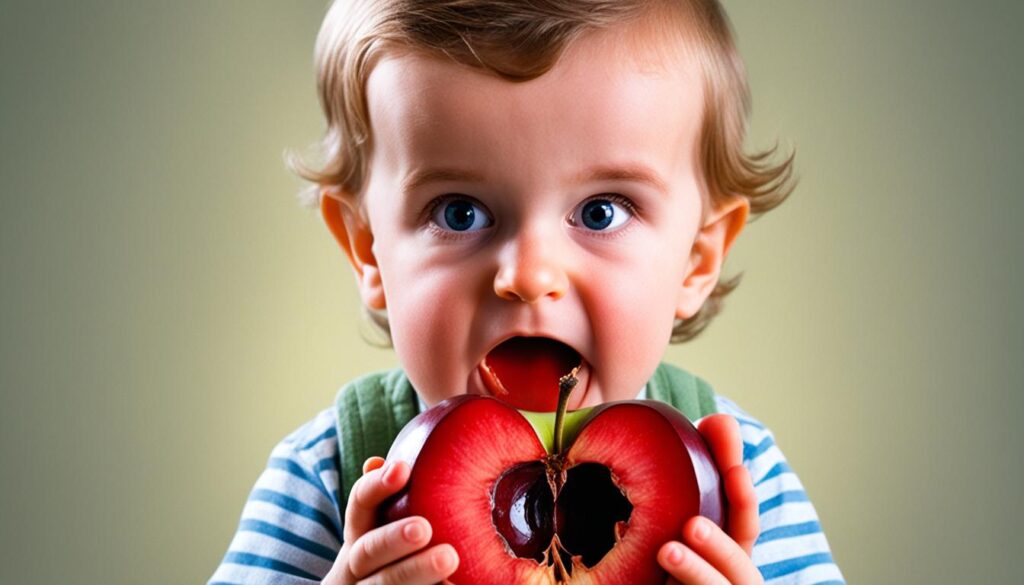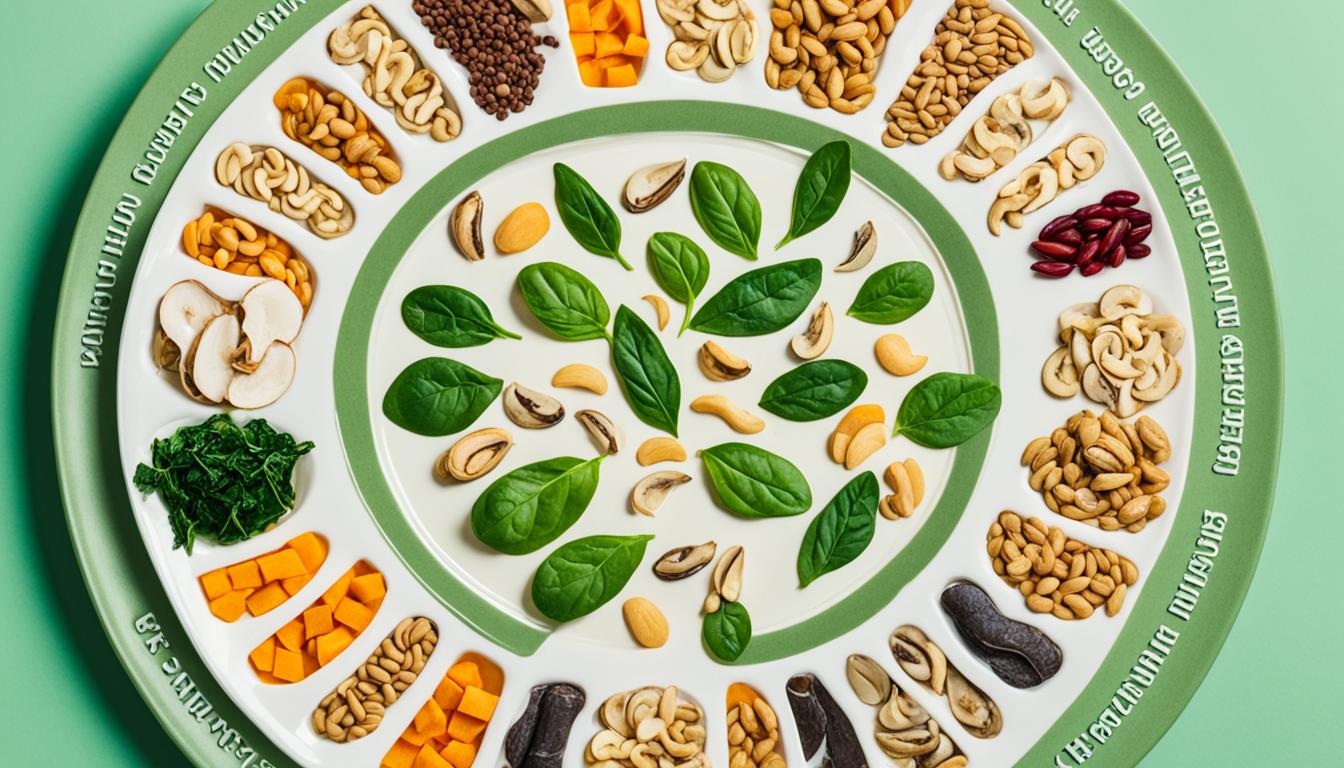Managing Iron Deficiency for Kids

Is your child getting enough iron? Iron deficiency is a common issue in kids that can affect their development and overall health. As parents, it’s crucial for us to take the necessary steps to ensure our children receive an adequate iron intake. But how do we know if our kids are at risk of iron deficiency? And what are the symptoms we should be aware of?
In this article, we will explore the importance of iron for children, the symptoms of iron deficiency, and the best sources of iron-rich foods for kids. By understanding how to manage iron deficiency, we can help our children grow and thrive.
Key Takeaways:
- Iron deficiency is a common problem in children that can affect their development and lead to anemia.
- Ensuring an adequate intake of iron is essential for children’s health and well-being.
- The recommended daily intake of iron varies based on age, and supplements may be prescribed in cases of deficiency.
- Certain groups of children are at a higher risk of developing iron deficiency, and awareness of the risk factors can help prevent it.
- Common symptoms of iron deficiency in children include pale skin, fatigue, poor appetite, and frequent infections.
Why is iron important for children?
Iron is a vital nutrient that plays a crucial role in the overall development and well-being of children. It is essential for several key functions in the body, including:
- Transporting oxygen from the lungs to the rest of the body
- Supporting muscle function and growth
Without sufficient iron, children may develop anemia, a condition characterized by a low level of red blood cells, or hemoglobin. Anemia can have significant impacts on a child’s growth, development, and overall health. Therefore, ensuring an adequate intake of iron is of utmost importance for children.
Iron deficiency is strongly associated with anemia in children and can lead to various symptoms and complications.
In order to paint a better picture of the role iron plays in children’s health, let’s take a closer look at some of the specific benefits of iron and its impact on child development:
1. Cognitive Development:
Iron is essential for proper brain development and cognitive function in children. It supports the production of neurotransmitters, which are critical for signal transmission between brain cells. Adequate iron levels can help enhance a child’s learning abilities, memory, and overall cognitive performance.
2. Physical Growth and Development:
Iron is involved in the production of red blood cells, which carry oxygen to various tissues and organs in the body. Sufficient iron levels promote healthy cell growth, aiding in physical development, muscle strength, and overall vitality.
3. Immune Function:
Iron plays a crucial role in supporting a healthy immune system. It helps in the production of white blood cells, which protect the body against infections and illnesses. Children with adequate iron levels are better equipped to fight off infections and maintain overall immune health.
As you can see, iron is not just another nutrient. It is a vital component necessary for proper growth, development, and overall well-being in children. By ensuring that children receive adequate iron through their diet and appropriate supplementation when needed, parents can help lay the foundation for a healthy and thriving future.
How much iron do children need?
The recommended daily intake of iron varies based on age. Babies are born with iron stored in their bodies, but as they grow, they require a steady supply of iron from food or supplements. The recommended amounts of iron for different age groups range from 7 to 15 mg per day. In cases of iron deficiency, supplements may be prescribed to meet the child’s iron needs.
Iron is an essential mineral that plays a vital role in a child’s growth and development. It is crucial for the production of hemoglobin, the protein in red blood cells that carries oxygen throughout the body. Without enough iron, children may develop pediatric iron deficiency, which can lead to symptoms such as fatigue, weakness, and impaired cognitive function.
To ensure children meet their daily iron needs, it’s important to include iron-rich foods in their diet. Good sources of iron include lean meats, poultry, fish, beans, and fortified cereals. However, it can sometimes be challenging for children to obtain sufficient iron from food alone, especially if they have a limited appetite or have dietary restrictions.
In such cases, iron supplements for kids can be a helpful solution. Pediatric iron supplements are available in various forms, such as drops, chewable tablets, or liquid formulas. They provide an additional source of iron that can help prevent or treat pediatric iron deficiency.
Did You Know?
Iron supplements for kids are specifically formulated to meet the iron needs of children and are often flavored to make them more palatable.
When considering iron supplements for kids, it is essential to consult with a healthcare professional who can assess the child’s iron status and recommend the appropriate dosage. While iron supplements can be beneficial, they should be used as directed and under the guidance of a healthcare provider to ensure safety and effectiveness.
Who is at risk of iron deficiency?
Certain groups of children are at a higher risk of developing iron deficiency. It is important for parents to be aware of the causes of iron deficiency in children and take preventive measures to ensure their children’s iron levels are adequate.
Children who were born prematurely or have a low birth weight are more susceptible to iron deficiency. Premature infants have lower iron stores at birth and may require additional iron supplementation to meet their needs.
Another group at risk includes children who consume cow’s milk before the age of one. Cow’s milk is low in iron and can interfere with the absorption of iron from other foods, leading to iron deficiency.
Children with restricted diets, such as those who follow strict vegetarian or vegan diets, may not get enough iron from their food sources alone. Iron from plant-based foods is less easily absorbed by the body compared to iron from animal products.
Children with chronic infections, such as gastrointestinal disorders or frequent respiratory infections, have an increased risk of iron deficiency. Infections can lead to inflammation, which can interfere with iron absorption and the body’s ability to utilize iron effectively.
Lead exposure is another risk factor for iron deficiency in children. Lead can affect the body’s ability to produce and utilize red blood cells, leading to lower iron levels.
By understanding these risk factors, parents can take steps to prevent iron deficiency in their children. Regular screenings and incorporating iron-rich foods into their diet can help ensure adequate iron levels and promote optimal health and well-being.
Symptoms of Iron Deficiency in Children
Iron deficiency in children can manifest in various ways. Some common signs of low iron levels include the following:
- Pale skin
- Fatigue
- Shortness of breath during exercise
- Cold hands and feet
- Slowed growth and development
- Poor appetite
- Behavior problems
- Frequent infections
Parents should be aware of these symptoms and consult with a healthcare professional if they suspect their child may have an iron deficiency.

Recognizing the Symptoms
“If your child exhibits any of these symptoms, it’s important to take them seriously. Iron deficiency can have a significant impact on a child’s health and development. Early diagnosis and treatment are crucial for managing the condition effectively,” says Dr. Emily Johnson, a pediatrician at ABC Pediatrics.
Preventing Iron Deficiency in Children
Preventing iron deficiency in children is essential for their overall health and well-being. By incorporating a combination of dietary measures and understanding the risk factors, parents can help ensure their children receive enough iron in their diet. Here are some tips to prevent iron deficiency in kids:
-
Serve Iron-Rich Foods
One of the best ways to prevent iron deficiency in children is by serving iron-rich foods. These foods provide a natural source of iron and are often more readily absorbed by the body compared to supplements. Some iron-rich foods for children include the following:
| Food | Iron Content (per serving) |
|---|---|
| Red meat (beef, lamb, pork) | 2-3 mg |
| Chicken (dark meat) | 1 mg |
| Fish (salmon, tuna) | 1-2 mg |
| Beans (kidney beans, lentils) | 2-3 mg |
| Spinach | 2-3 mg |
Limit Milk Intake
Although milk is a good source of nutrients, excessive milk consumption can interfere with iron absorption. It is recommended to limit milk intake to no more than 24 ounces (710 ml) per day for children aged 1-3 years and no more than 16 ounces (480 ml) per day for children aged 4–8 years. By reducing milk consumption, children will have more room in their diet for iron-rich foods.
Offer Foods Rich in Vitamin C
Vitamin C enhances iron absorption, making it an important component of preventing iron deficiency in children. Encourage your child to consume fruits and vegetables rich in vitamin C, such as oranges, strawberries, bell peppers, and tomatoes. Adding these foods to meals containing iron-rich foods can help maximize iron absorption.
By implementing these preventive measures, parents can take proactive steps to ensure their children maintain healthy iron levels and reduce the risk of iron deficiency.

References:
- Australian Government Department of Health. (2021, June). Iron: health professional fact sheet. Healthdirect. Retrieved from https://www.healthdirect.gov.au/iron-health
- CDC. (2021, March 4). How to get the iron you need. Retrieved from https://www.cdc.gov/ncbddd/spanish/irondeficiency/how-much.html
- Storniolo, C. E. T., & Moreno, Y. F. (2017). Iron deficiency in children: prevention tips for parents. Informed Health Online. Retrieved from https://www.ncbi.nlm.nih.gov/books/NBK435668/
Diagnosing Iron Deficiency in Children
Diagnosing iron deficiency in children involves conducting blood tests to determine their iron status. Healthcare professionals often recommend screening all infants between 9 and 12 months of age for iron deficiency anemia. Additionally, children with risk factors for iron deficiency should undergo periodic testing to monitor their iron levels.
Blood tests, including assessments of hemoglobin and hematocrit levels, provide valuable insights into a child’s iron status. These tests help healthcare professionals identify whether a child has an iron deficiency and determine the severity of the condition. By analyzing the blood test results, healthcare professionals can tailor appropriate treatment plans to address the child’s iron deficiency.
If a child is diagnosed with iron deficiency, healthcare professionals may prescribe iron supplements to boost their iron levels. Iron supplements for children are available in various forms, such as drops or pills. The dosage and duration of iron supplement treatment will depend on the child’s specific needs, as determined by the healthcare professional.
It is important for parents to follow the healthcare professional’s guidance regarding iron supplements and provide them to their child as prescribed. Iron supplements, when taken correctly, can help replenish iron stores in the body and alleviate symptoms associated with iron deficiency.
To further evaluate a child’s iron status or identify any underlying conditions contributing to iron deficiency, healthcare professionals may recommend additional testing or consultations with specialists. These steps ensure a comprehensive approach to pediatric iron deficiency management and help optimize the child’s health and well-being.

- The diagnosis of iron deficiency in children involves blood tests to assess iron levels.
- Screening for iron deficiency anemia is often recommended for infants between 9 and 12 months of age.
- Children with risk factors for iron deficiency should undergo periodic testing.
- Blood tests, including hemoglobin and hematocrit assessments, help determine a child’s iron status.
- Iron supplements may be prescribed to boost iron level children with iron deficiency.
- Parents should follow healthcare professionals’ recommendations for iron supplement dosage and duration.
Treating Iron Deficiency in Children
Treatment for child iron deficiency anemia involves addressing the underlying cause and increasing iron levels. There are various approaches to treating iron deficiency in kids, including:
-
Iron Supplements:
Iron supplements are available in different forms, like drops or pills. They provide a concentrated source of iron to help raise iron levels in children. It is important to follow the healthcare professional’s recommendations regarding the appropriate dosage and duration of treatment.
-
Iron-Rich Foods:
In addition to supplements, incorporating iron-rich foods into a child’s diet is crucial. Foods such as red meat, chicken, fish, beans, spinach, and fortified cereals are excellent sources of dietary iron. Including these foods regularly can help enhance iron levels in the body.
By combining iron supplements and iron-rich foods, parents can effectively manage and treat iron deficiency in their children. It is essential to consult with a healthcare professional for proper guidance on treatment options and to monitor the child’s progress.
Iron deficiency in children is a common yet preventable condition that can significantly impact their health and development. Adequate iron intake is crucial for children’s overall well-being and growth. By understanding the importance of iron, recognizing the symptoms of deficiency, and taking preventive measures, parents can ensure their children maintain optimal iron levels for their health.
Regular screening is essential to identify iron deficiency in children at an early stage. Healthcare professionals may recommend blood tests to assess iron status and detect any deficiencies. If diagnosed with iron deficiency, appropriate treatment, including iron supplements and dietary adjustments, can help manage and improve iron levels. Following the healthcare professional’s recommendations for dosage and duration is crucial for effective treatment.
Promoting children’s health and iron levels requires a multi-faceted approach. In addition to iron supplements, parents should focus on providing a balanced diet rich in iron sources such as red meat, chicken, fish, beans, and spinach. It is equally important to limit milk intake and incorporate foods rich in vitamin C into their diet, as it enhances iron absorption.
By prioritizing children’s iron intake and addressing iron deficiency proactively, parents can safeguard their children’s health and support their overall development. Regular check-ups, awareness of symptoms, and implementing preventive measures can go a long way in ensuring optimal iron levels and promoting children’s well-being.
FAQ
What are the symptoms of iron deficiency in children?
How can I prevent iron deficiency in my child?
How is iron deficiency in children diagnosed?
What is the treatment for iron deficiency in children?
Why is iron important for children?
How much iron do children need?
Who is at risk of iron deficiency?
How can I manage iron deficiency in my child?









